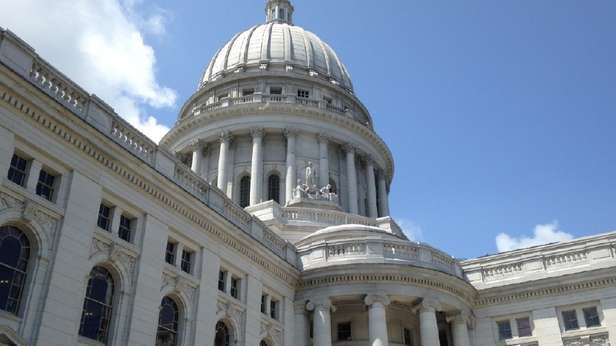
April 3, 2017
By James Wigderson
Special Guest Perspective for the MacIver Institute
I’m old enough to remember when the band REM came out with a song about Wisconsin’s structural deficit, “It’s the end of the world as we know it, and I feel fine.” For you kids in the audience, that was when we actually paid to listen to music and band members actually played instruments.
Now get off my lawn.
Of course, the world didn’t end in 1987 despite the threat of nuclear war or whatever the song was really about, and the world won’t end at the end of the next budget biennium when Wisconsin will supposedly have a structural deficit of $1.1 billion. The world didn’t end when the state government had structural deficits in the past, too. Somehow the state always ends up spending more money than it did the previous biennium.
Because despite the headline in the Wisconsin State Journal about a $1.1 billion “budget hole,” there is no actual deficit. Despite the “$1 billion shortfall” in the headline of the Milwaukee Journal Sentinel, there is no actual shortfall. Perhaps the newspapers should add a feature where their headlines are read by Count Floyd, because what they’re describing is less scary than a stack of pancakes.
Wisconsin’s budget is on a two-year cycle so legislators can debate it in off years and then re-debate it on the campaign trail in election years. The two-year cycle is supposed to insulate the budget process from politics, but we live in a state where buying a pizza is a political act.
Our state also has a non-partisan agency, the Legislative Fiscal Bureau (LFB), that looks at state spending and provides analysis. In the (LFB) memo quoted by the newspapers and your favorite Democrats, Wisconsin’s state budget doesn’t end with a deficit. It actually ends with a $12 million surplus. See the LFB’s Table 1 below:

In addition to the $12 million, over the next two years Wisconsin will add $20 million to the budget stabilization fund. The “rainy day” fund will be $302 million at the end of the budget cycle.
And the $12 million isn’t even $12 million. It’s actually $87 million because state law requires the state to keep $75 million on hand. Think of it as that minimum amount you keep in your checking account to allow you to pay bills at different times of the month while your paycheck varies each pay period. Wisconsin revenue goes up and down, but the state still keeps enough on hand to pay the bills as they come in.
So where does this $1.1 billion “structural deficit” come from? In the LFB memo, they projected the expenditures necessary for the next budget cycle after this coming budget cycle based upon the proposed spending in the last year of this budget cycle. In other words, while Wisconsin is just starting to debate the 2017-2019 budget, the LFB is using the proposed spending for 2018 and guessing what will be the spending need for Wisconsin in the 2019-2021 budget.
Not surprising, given the constantly growing size of government, we’re not expecting (yet) enough revenue for everything the government will want to spend money on in 2020 and 2021. We also don’t know if we’ll finally have flying cars, hoverboards that actually don’t need wheels, or even who the governor will be.
However, if you look at the numbers, they do look more scary than the monsters under your accountant’s bed. In the first fiscal year after the next budget, three fiscal years from now, the state’s projected spending is expected to exceed revenues by $420 million. The next year, four fiscal years from now, is even worse when the state’s projected spending is expected to exceed revenues by $633 million. Rounding up, that’s where the $1.1 billion figure comes from.
Given this “end of the world” scenario, why should we feel fine? Because under Governor Scott Walker, the state has had a structural deficit every budget cycle, and each time the state has actually finished with a surplus. Four budgets, four surpluses, and the rainy day fund just keeps getting bigger.
In fact, the so-called structural deficit keeps going down. Under former Governor Jim Doyle, the structural deficit at the end of his tenure was $3.6 billion, double the structural deficit in the last budget cycle of $1.8 billion. Now we’re projecting a structural deficit of $1.1 billion. If we ever get to the point where there is no structural deficit, Wisconsin will be collecting far too much tax revenue.
Lost in the scary world of so-called “structural deficits” is the requirement in state law that the budget has to be balanced. There is no deficit spending in Wisconsin, unlike at the federal level and in other states.
The last time Wisconsin was in a real deficit situation, Walker inherited from Doyle an actual $137 million deficit in 2011. In addition, the state owed the medical malpractice fund $200 million and owed the state of Minnesota $58 million. While lurching from crisis to crisis, Doyle raised taxes billions of dollars, spent federal stimulus money and raided the transportation fund, and still could not balance the budget. Under Doyle, the state was listed by Pew Research as a state in fiscal peril.
That was the year Wisconsin passed Act 10, and that act alone has saved taxpayers over $5 billion and counting.
So do not tremble at the sound of the structural deficit. Do not despair that the four horsemen of the fiscal apocalypse are coming for Wisconsin. As long as the state continues to grow, so will the state budget. Unfortunately.